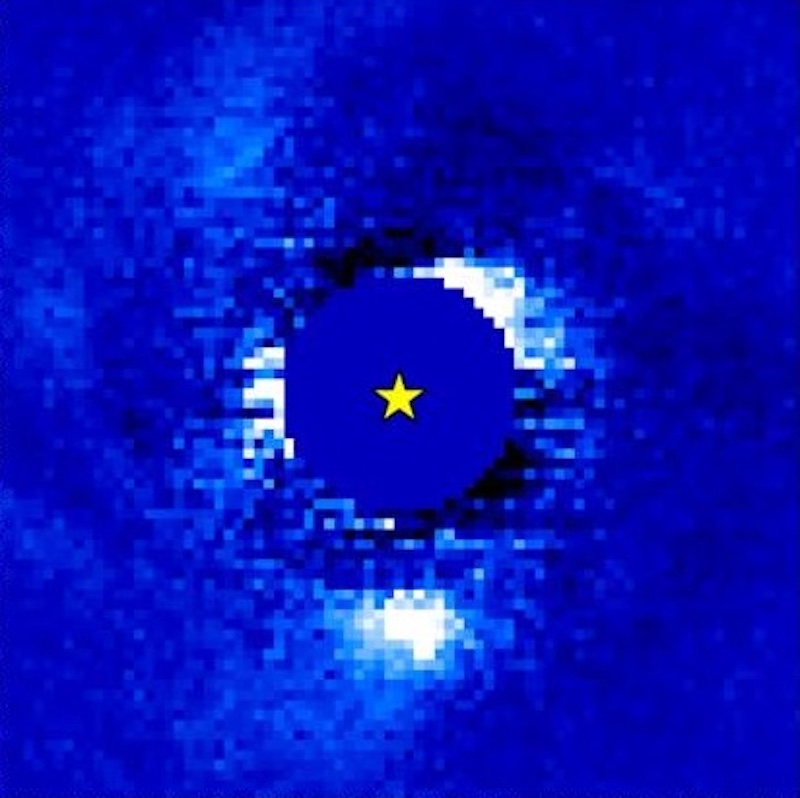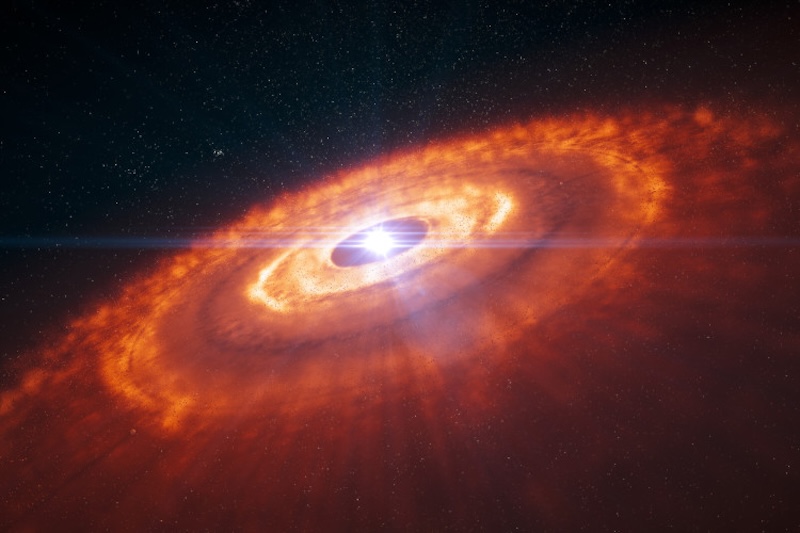 Image from the Very Large Telescope (VLT) in Chile showing the growth of baby planet AB Aurigae b (bright spot near the bottom) in its protoplanetary disk. Image via T. Currie et al./ The Astrophysical Journal Letters (CC BY 4.0).
Image from the Very Large Telescope (VLT) in Chile showing the growth of baby planet AB Aurigae b (bright spot near the bottom) in its protoplanetary disk. Image via T. Currie et al./ The Astrophysical Journal Letters (CC BY 4.0).
- Baby planets, or protoplanets, form in protoplanetary disks of dust and gas around young stars. Astronomers have found most of them in gaps within the disks.
- Astronomers have re-observed the protoplanet named AB Aurigae b, about 500 light-years away. New data provided clues about how it is gathering material and growing.
- AB Aurigae b is embedded within the disk itself, instead of in a gap. This is the first time such a protoplanet has been observed growing as it is still shrouded in dust and gas.
Active growth of baby planet
Protoplanets are baby planets still in the process of forming in stars’ protoplanetary disks of dust and gas. Astronomers have found many such protoplanets around young stars. But on September 5, 2025, an international team of astronomers said that, for the first time, it has directly glimpsed evidence of a growing protoplanet – AB Aurigae b – while it’s still shrouded in dust and gas in its disk. Using the Very Large Telescope (VLT) in Chile, the team detected a signature of hydrogen from the protoplanet that provided the clues.
Unlike most protoplanets found so far, this one is still embedded within the dusty material of the disk instead of being in a cleared-out gap in the disk. AB Aurigae b is about 500 light-years away from us.
The new study includes researchers from the Astrobiology Center (ABC) in Japan, the University of Tokyo, the National Astronomical Observatory of Japan (NAOJ), Kogakuin University, the University of Texas at San Antonio and Peking University in China.
Thayne Currie, at the University of Texas at San Antonio and the Subaru Telescope at the National Astronomical Observatory of Japan, is the lead author of the new study.
The researchers published their peer-reviewed findings in The Astrophysical Journal Letters on September 2, 2025.
And here we are … our paper reporting the detection of the AB Aurigae b protoplanet with VLT/MUSE spectroscopy!arxiv.org/abs/2508.18351
— Thayne Currie ?? (@astrothayne.bsky.social) 2025-08-27T02:23:45.798Z
 Thayne Currie at the University of Texas at San Antonio and the Subaru Telescope at the National Astronomical Observatory of Japan is the lead author of the new study about AB Aurigae b. Image via Bluesky.
Thayne Currie at the University of Texas at San Antonio and the Subaru Telescope at the National Astronomical Observatory of Japan is the lead author of the new study about AB Aurigae b. Image via Bluesky.
Hydrogen emission provides hint
The researchers used the Multi Unit Spectroscopic Explorer (MUSE) spectrograph on the Very Large Telescope for their observations. The detected a hydrogen emission coming from AB Aurigae b. That emission is evidence for material from the protoplanetary disk falling onto the protoplanet. MUSE can detect extended structures of gas or dust, such as the hydrogen emission.
Astronomers have detected hydrogen emissions in protoplanetary disks before. But those have been associated with the protoplanets PDS 70 b and PDS 70 c that are now residing in cleared-out gaps in the disk. In this case, however, the protoplanet is still embedded within the gas and dust of the disk itself and hasn’t created a gap yet. This means it is also one of the youngest protoplanets ever found so far. In 2021, astronomers even found a possible moon-forming disk around PDS 70 c!
The researchers note in the paper that while an alternative explanation other than material accreting onto the protoplanet is possible, they consider it to be less likely. Currie said on Bluesky:
So cased closed, right? AB Aur b = embedded but accreting protoplanet. MUSE shuts the door on mystery about the system …
NOPE. Evidence favors AB Aur b as a site of active planet formation. But ‘maybe’ the MUSE detection itself is from ‘something else.’ We ‘mused’ (get it?) about some contrived scenarios … ‘Possible?’ AB Aurigae is just. plain. WEIRD.
 View larger. | Artist’s illustration of a large protoplanetary disk. The gaps are where new planets are forming. Image via ESO/ L. Calçada.
View larger. | Artist’s illustration of a large protoplanetary disk. The gaps are where new planets are forming. Image via ESO/ L. Calçada.
AB Aurigae b and planetary formation
Although AB Aurigae b is still a baby planet, it is huge, about four to nine times the mass of Jupiter. It orbits far away from its young star, at 93 astronomical units (AU). For comparison, Earth’s orbit is 1 AU. And even Neptune’s average distance is only 30 AU.
Interestingly, standard planetary formation models don’t fully explain how such a large planet would form so far from its star. However, the gravitational instability hypothesis might be able to explain it. In this scenario, the disk itself becomes gravitationally unstable and collapses to form the planet. That’s unlike core accretion, which occurs when grains of dust in the disk collect and grow to form a planetary core.
Bottom line: Using the Very Large Telescope, astronomers have seen the growth of baby planet AB Aurigae b. It is still surrounded by dust in its protoplanetary disk.
Source: VLT/MUSE Detection of the AB Aurigae b Protoplanet with H alpha Spectroscopy
Read more: Baby planet caught carving a path in its star’s dusty disk
Read more: 1st planet-forming disk found in another galaxy
Paul Scott Anderson
View Articles
About the Author:
Paul Scott Anderson has had a passion for space exploration that began when he was a child when he watched Carl Sagan’s Cosmos. He studied English, writing, art and computer/publication design in high school and college. He later started his blog The Meridiani Journal in 2005, which was later renamed Planetaria. He also later started the blog Fermi Paradoxica, about the search for life elsewhere in the universe.
While interested in all aspects of space exploration, his primary passion is planetary science and SETI. In 2011, he started writing about space on a freelance basis with Universe Today. He has also written for SpaceFlight Insider and AmericaSpace and has also been published in The Mars Quarterly. He also did some supplementary writing for the iOS app Exoplanet.
He has been writing for EarthSky since 2018, and also assists with proofing and social media.